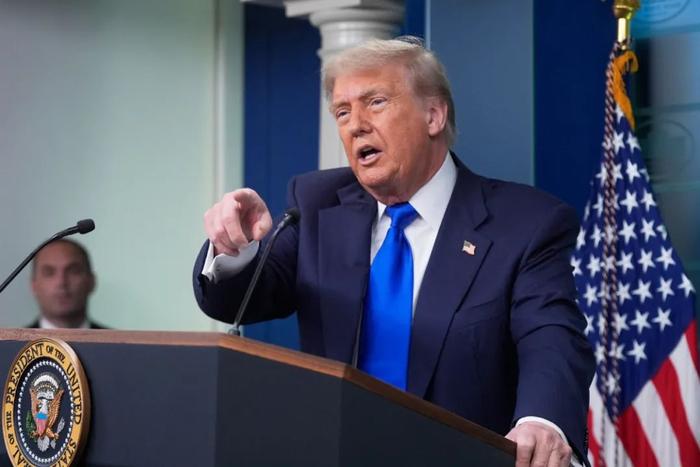
According to Xinhua News Agency, the U.S. Supreme Court ruled on June 27th regarding President Trump’s attempt to widely implement his executive order restricting “birthright citizenship,” ruling that individual judges cannot prevent the president’s orders from taking effect nationwide. This means
that the restriction on “birthright citizenship” can begin to be enforced.
Three liberal Supreme Court justices expressed dissent over this ruling.
Justice Sonia Sotomayor described the Trump administration’s measures as “flagrantly unconstitutional” and “manipulative.”
At the same time, immigration groups in the United States expressed disappointment and discontent, stating that this move would bring about
“chaos, inequality, and fear.”
The Trump administration welcomed the Supreme Court’s decision.
President Trump claimed it was a “great victory” on social media.
On June 27, 2025, local time, in Washington D.C., U.S. President Donald Trump responded to questions about recent Supreme Court decisions during a press conference at the White House. Photo credit: Visual China
Trump Seeks to Abolish “Birthright Citizenship”
The policy of “birthright citizenship” has been in place in the United States for over 150 years. The Fourteenth Amendment to the U.S. Constitution, passed in 1868, provided for “all persons born or naturalized in the United States, and subject to the jurisdiction thereof, are citizens of the United States and the state where they reside.” This clause grants U.S. citizenship to all individuals born in the United States, meaning even those who hold tourist, work, or other visas, including illegal immigrants, can have their children become U.S. citizens if they were born in the country.
On January 20th of this year, Trump signed an executive order to repeal “birthright citizenship,” which stated that newborns of parents not U.S. citizens or legal permanent residents could not automatically receive U.S. citizenship, causing widespread outrage.
The U.S. District Courts in several states immediately froze the executive order, and federal district judges in Maryland, Washington, and Massachusetts ruled it unconstitutional, preventing its nationwide implementation.
Subsequently, Trump requested the Supreme Court to intervene. Regarding the Fourteenth Amendment, the Trump administration stated that the “residency” clause means that children of non-permanent or non-legal residents of the United States are excluded.
On the 27th, the conservative-controlled U.S. Supreme Court approved Trump’s request with a 6-3 vote, limiting the scope of the federal district court’s injunction to only apply to the states, groups, and individuals filing lawsuits. However, the ruling did not address whether the executive order restricting “birthright citizenship” itself was unconstitutional.
Two Categories of People Will Lose Their American Citizenship
U.S. media believe that the above ruling is favorable for the Trump administration to gradually take measures to end “birthright citizenship.”
According to Trump’s executive order on abolishing “birthright citizenship,” the U.S. government will no longer recognize the citizenship status of two categories of people:
First, when someone is born, if their mother is illegally present in the U.S. and their father is not a U.S. citizen or a lawful permanent resident; Second, when someone is born, if their mother is legally temporary present in the U.S. and their father is not a U.S. citizen or a lawful permanent resident.
According to U.S. media reports, Trump’s executive order had a 30-day grace period before it took effect, meaning that currently, “birthright citizenship” has not been abolished, and people born in the United States remain citizens.
After the U.S. Supreme Court made its ruling, how can the actual implementation of Trump’s executive order be carried out?
Reports indicate that the U.S. government needs to draft regulations specifying the details of the executive order’s implementation, such as whether pregnant women now need to bring their passports or birth certificates to hospitals in the U.S. The White House has not provided clear statements on these details, and the Department of Justice has not explained how the government plans to implement the executive order.
After the Supreme Court’s ruling, federal district courts in states such as Maryland and Massachusetts will have to re-examine the nationwide bans issued in their state and make modifications or narrow them down to only apply to the plaintiffs who had previously filed lawsuits. The plaintiffs include the attorneys general of 22 U.S. states and immigrant rights groups.
However, for the 28 states that have not filed lawsuits, the Trump-signed order to repeal “birthright citizenship” will take effect within 30 days.
A poll conducted by the Emerson College Poll Center on American registered voters from June 24th to 25th showed that 68% of voters support “birthright citizenship.” On this issue, there is a clear partisan divide; 90% of Democrats support “birthright citizenship,” while only 49% of Republicans believe the system can continue to be retained.